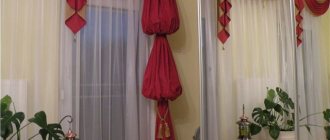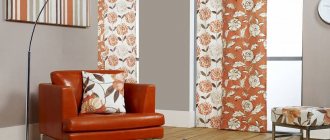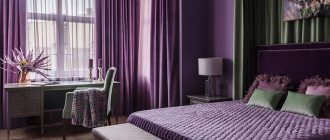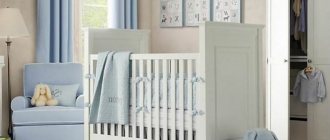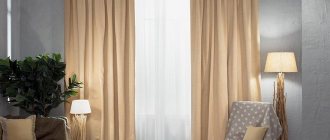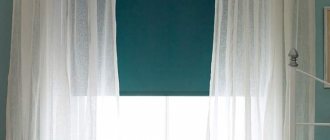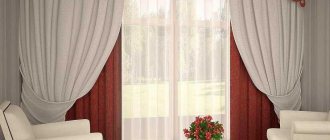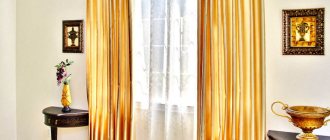Curtains are necessary in any room primarily to protect it from unwanted prying glances.
Bare frames do not look particularly attractive and do not add coziness, so when decorating windows they often resort to transparent curtains, which allow light to freely penetrate the room, creating a light haze effect and giving the interior a sophisticated look.
The most common material for this type of curtain is organza, as it fits perfectly with any other material and looks more than solid.
This lightweight and incredibly beautiful fabric is created using a complex technology in which silk fibers are twisted with polyester or viscose fibers.
There is a wide range of similar material on the market, as can be seen in the photo of organza curtains, both in color and quality of fabric.
It can be matte, shiny, crinkled or smooth, with perforation, printed, or ornamented. There are ways to further process the fabric, and then it will be decorated with sequins, complemented with aluminum or gold threads.
Modern types of material look the most attractive: chameleon, in accordance with its name, changes color when the lighting changes; the rainbow version is painted with color stripes that merge into each other, which allows you to create combined organza curtains.
Advantages and disadvantages of organza
Organza consists of natural or synthetic fibers, is weightless and durable, transmits and diffuses sunlight, and is easy to care for.
| Advantages | Description |
| Unlimited choice of colors and textures. Versatility - can be combined with any material. High level of strength due to a special technique of twisting threads in the manufacture of fabric. Resistance to fading in the sun. Light and breathability. Practicality - easy to wash and iron. | The fairly rigid texture of the fabric does not always lend itself to complex drapery. |
Types of curtains
Today, designers widely use various styles to decorate windows. If desired, textiles on the window can become either a soft and organic addition to the overall interior concept, or a luxurious color or texture accent of the room.
Curtains
In modern interiors, curtains are most often called curtains that are made from light and thin fabrics - organza, tulle and veil. These can also be thick, plain curtains made of smooth materials with even weaving.
Fabrics made from natural fibers with a patterned, checkered or cellular structure that are highly breathable can be an ideal option for making curtains.
The photo shows a living room in a modern style with translucent organza curtains.
Double
Double curtains are those whose fabrics are combined one on top of the other. In the decor of this type of curtains, lambrequins and a combination of two translucent curtains are often used. Multilayer curtains made of translucent organza will decorate and visually enlarge a small window.
Roman
Such curtains are made of smooth fabric, which is divided into equal sections. Each horizontal section is secured by a sewn-in strong and lightweight rod. To raise the curtain, you need to pull the cord, which is attached to the wrong side. With their help you can dim the bright daylight. And in order not to create a gloomy atmosphere, you should use translucent fabrics, such as organza.
French
This type of curtain is often called “awning”. French curtains consist of sections that are formed by semicircular folds, evenly distributed throughout the entire canvas. An awning made of silk organza or tulle goes well with lambrequins and curtains.
Austrian
The Austrian curtain is distinguished by voluminous scallops at the bottom of the canvas. At the top the curtain is draped manually or using curtain tape. These curtains are made from translucent fabrics. Depending on the purpose, it is practical to use them in the kitchen to create an airy effect and create a practical short length to the windowsill. In the living room or bedroom, paired with heavy curtains, Austrian curtains will add an accent of luxury to the interior of the room.
With photo printing
This type of curtain involves choosing any photographic image, for example a city or natural landscape, and then applying it to the canvas.
We sew curtains with our own hands
Organza curtains are very easy to sew yourself.
Even those housewives who have absolutely no sewing skills can cope with this.
First you need to choose the right type of fabric. Currently, the fabric market offers such a wide range that you can choose one for absolutely every taste.
Iridescent, silver, golden, with a “chameleon” effect or simply matte.
The shade of the fabric can either softly emphasize the overall interior of the room or focus attention on the window. A correctly selected pattern should be in harmony with the wallpaper.
Having selected the desired type of material, we calculate how many meters of fabric will be needed to sew curtains.
The length is measured from the curtain rod hooks to the floor and 2 centimeters are added.
The width is calculated based on the length of the cornice multiplied by the assembly factor. As a rule, for thin fabrics such as organza, a factor of 3 is taken.
For example, we multiply a cornice 3 meters long by a factor of 3. It turns out that for a three-meter cornice we need 9 meters of fabric. Add 10-15 centimeters for processing.
In addition to cutting the fabric of the required size, to sew curtains you will need:
- ribbon. Curtains are attached to it;
- binding. The bottom edge is treated with it (to match the color of the fabric);
- sewing machine;
- pins, needles, threads, scissors.
The machine must be adjusted and configured in advance. To avoid damaging the fabric, use only sharp needles. The threads should be strong, but thin enough.
Varieties of organza
Fashion trends suggest the use of new types of organza when decorating windows. Created using innovative thread weaving technologies, these types of fabrics give the effect of additional scattering of sunlight, play of color and shimmer in artificial lighting.
- Crash. This type of organza is also called “broken glass effect”. The texture of the fabric is uneven, as if cracked.
- Reaped. Or tergalet. The pattern on the fabric is similar in appearance to crash and also has a raised “crumpled” texture.
- Devore. This organza alternates dense and transparent sections of the fabric. In production, this effect is achieved by etching the fabric with specially selected reagents.
- Rain. Small dense threads are woven into the organza fabric, imitating a rain pattern.
- Chameleon. This type of fabric has an iridescent texture and silky shine.
Dimensions
When choosing the parameters of a future curtain composition, in particular the length of the canvas, designers take into account:
- room height;
- color of walls and furniture;
- functionality of the room - living room, kitchen or bedroom.
Long
Floor-length or softly draping curtains on the floor will never go out of style. If the room is located on the south or southeast side, then long, thick curtains are suitable for protection from light. For those who love bright light, curtains made of light and light organza are suitable.
The photo shows long curtains made of brown translucent organza in combination with thick curtains.
Short
Curtains up to the length of the window sill can be used indoors for practical purposes - in the kitchen and in the nursery, to avoid frequent contamination. So it is with the aesthetics - in the design of a room with a modern style, the window frame is often decorated with short Roman blinds of dense texture. If the interior needs more light and lightness, then they are combined with airy floor-length curtains.
Organza in the kitchen
Thanks to its practicality, organza will not cause any trouble in the kitchen. Even if the curtains get dirty often, they are easy to wash. But it is not recommended to keep them close to the stove; for safety reasons, you can hang shortened or Roman blinds. An interesting option for the kitchen interior is dividing curtains. You can hang organza separating the dining and kitchen areas, thus giving the room functionality. In addition, organza curtains are suitable for creating almost any kitchen design; they can be combined with any fabrics, colors and textures.
Color spectrum
A color scheme is a combination of colors and their shades that are in harmony with each other, which means they can be combined in decor and textiles when decorating an interior.
Selecting the right colors for interior design is an important task, since different shades have the ability to influence mood and physical state: some tones excite the nervous system, while others, on the contrary, calm it.
Beige
This color is an excellent base for other richer and brighter shades. In addition, the palette of beige in milky, cappuccino, ecru and caramel shades allows it to be used in a monochrome design. Designers use this method to achieve the effect of calm and softness in the interior.
White
White organza curtains have the ability to visually enlarge the space. The color white evokes positive images: the white dove is a symbol of peace and friendship. There are more than 10 shades of white, both cold and warm, for example, platinum and milky tones. Choosing the right tone will allow you to harmoniously combine the tulle with the rest of the curtain composition.
The photo shows a classic-style dining room with window decorations in the form of white translucent organza curtains.
Green
The spectrum of green shades has a beneficial effect on well-being and mood, as it is associated with living nature. In this case, you can choose soothing warm and pastel colors for the bedroom or invigorating cold and bright ones for the living room.
Black
Designers often use this achromatic shade in the interior as a stylistic accent. For example, black organza curtains are a strict and effective element in the interior of a room with light walls, a high ceiling and modern-style furniture.
Blue
This is the name of the shade of blue in the spectrum. It has a direct association with clear skies and dreams. Using this color in window decoration helps achieve the effect of lightness and harmony.
Brown
This is a shade that is not included in the spectrum of primary colors. There are more than 100 shades of brown. Designers very often combine this color with beige tones.
Pink
An easy-to-see color created by mixing red and white. Delicate shades of pink are appropriate to use in the decor of children's rooms and bedrooms.
Yellow
In the color spectrum, yellow is between orange and green, so it combines well with these colors. It can also be used independently - as a base color (at low saturation) and as an accent on the window - in a bright version.
Red
This color has a powerful stimulating effect on mood, so its use in the interior should be measured and thoughtful.
Styles
Interior style is a complex of distinctive properties inherent in different directions in finishing, furnishing and decorating premises.
Provence
French provincial style refers to the southern and light directions. In the interior, the use of this style creates a relaxed atmosphere of a country house.
Minimalism
The name of this style is derived from the word minimus - smallest. It accurately reflects his concept in interior and decor - conciseness, simplicity and precision.
The photo shows an interior in a minimalist style with monochrome decor on gray organza windows.
Classic
In the interior, a classic is the creation of exemplary and typical images. Namely, precise proportions, baroque or empire design of furniture and decoration. Textile design includes intricate patterns, lush draperies and expensive fabrics. The decoration uses beads, lace, curls, embroidery and gold.
Modern
When creating a modern style in a room, designers use fashion trends and experiment with finishes, colors and textures.
Organza curtains in two colors
This season, the trend is multi-layering and combining curtains of the same texture but different colors in the interior. Two-color curtains made of organza look especially impressive on one window. They can be hung side by side, overlapping, left hanging in even folds that are soft to the floor, or draped beautifully. You can combine colors in three ways:
1 Choose curtains of different shades of the same color. For example, dark blue and light blue, rich green and pale light green, chocolate and beige. This solution is suitable for classic and romantic interiors.
2 “Color” the curtains in colors that are harmonious in relation to each other. This technique is typical for “rustic” interior styles: country, Provence, shabby chic. The most winning examples of such combinations are:
- red with pink, purple, orange and yellow;
- orange with red, pink and yellow;
- yellow with orange and light green;
- green with blue;
- blue with green and lilac;
- purple with blue, lilac and pink.
3 Play on contrasts. This method is suitable for avant-garde interiors and lovers of bright and original design. The contrasting (antipodean) colors of the palette are as follows:
- green - red;
- blue yellow;
- yellow - lilac;
- pink - light green;
- lime - purple.
In addition, a combination of any (prevalent in the room) color with white is considered a win-win, suitable for all interior styles.
Organza curtains are the optimal solution in all respects: an obedient and durable material that perfectly retains its shape, makes it possible to experiment with the type of curtain, combine different colors and textures, boldly use accessories and decorations without fear of spoiling the composition.
Curtain design
Creating a harmonious and unique decor for a window is a difficult creative task for a designer. He is required to have professionalism, accuracy of calculations and great creativity. When developing the design of curtains, it is necessary to take into account all the details, namely: the area and illumination of the room, the size and shape of the windows, the color design of the walls and the style of furniture.
- Rainbow ones. This design is especially suitable for children's rooms.
- Asymmetrical. They create a play of light and shadow and can be an original accent in a room.
- Gradient. A fashionable design with a color transition from delicate to rich shades is used in interiors with a modern style.
- With embroidery. The luxurious appearance of this decor is suitable for interiors in a classic style.
- With gold. The design using gold and silver ornaments gives the room a rich and elegant look.
- With sagging threads. A versatile and fashionable combination of organza with sagging threads is suitable for creating a bright accent in the living room, bedroom or kitchen. The sag threads can be matched to the tulle or combined in contrasting colors.
Beauty with functionality goes a long way!
If you choose organza for the kitchen, then a lot depends on the chosen room design. The taste qualities of the homeowners also play an important role. Such curtains look beautiful, even if the curtains are not included in the complex.
Read: Turquoise curtains - 70 photos of interior ideas
In addition, curtains are not always needed, which is why they often choose exclusively organza, thanks to which light penetrates during the day without difficulty, illuminating the room with natural light. At the same time, it will to some extent cover what is outside the window.
Drawings
Curtains with patterned designs are a fashionable trend in window decoration. Curtains and wallpaper with the same pattern look especially interesting. A wide range of styles from romantic colors to strict graphic forms will help realize any creative request.
Geometry (stripe, check)
The striped design looks harmonious in interiors with a modern style.
In the photo on the left, the kitchen is decorated with bright organza curtains with a striped design.
Flowers
Among the most popular floral patterns for curtains are bright red poppies, sunny daisies, exquisite lilies and laconic sakura. In addition, the design of curtains with large flowers looks impressive, especially in spacious rooms.
Tree
Curtains with a tree pattern serve as a harmonious completion of an eco-style interior. They create a unique character for the room.
Butterflies
A pattern with butterflies on curtains is always relevant. It is often used by designers when decorating girls' rooms.
In the photo on the left is a bedroom for a girl with decor on the windows in the form of white translucent curtains with a pattern of butterflies.
Monograms
In the Middle Ages, a monogram meant writing initials with a beautiful interlacing of lines. Today this pattern is used to create decoration in the form of a complex pattern on the curtain fabric.
Options for using organza in window decoration
Organza can be safely used in combination with Roman blinds. This solution will be a good option for any room.
This material also looks great as a “stand-alone” curtain (the softness and airiness of the fabric in this case should be emphasized by gathering it in soft waves - for example, using eyelets).
Another trendy way to decorate a window using organza is to combine the fabric with curtains made of denser materials.
Compositions made from several types of organza, differing in texture, pattern or color, came into fashion in 2020.
Organza goes well with hard and soft lambrequins and massive cornices.
Organza is one of the most versatile materials for decorating window openings. It can be used both as “independent” curtains and combined with all types of sliding and lifting curtains that are popular today as curtains.
Another fashionable combination today is organza and blinds. In this combination, blinds can be anything: vertical, horizontal, with plastic, aluminum, fabric and even wooden slats. They are attached closer to the window, on the opening or directly on the sashes. Delicate and airy organza hangs in front of them, softens their strict lines and brings romantic notes to the interior.
There are many varieties of organza, because today this material is in great demand in interior design. Here are just some of the new curtains made from this unique fabric that have appeared on the market in recent years:
- Chameleon curtains are curtains made of fabric that changes color depending on the viewing angle and light intensity.
- Organza in high-tech style - curtains with aluminum inserts and stitching dividing them into stripes of different widths and shades.
- Organza curtains with the effect of snow sparkling in the bright sun.
- Organza curtains with photo printing. Thanks to the transparent texture of the fabric, the image on them looks as if illuminated from within and very realistic.
- Crash curtains. Organza in the “crash” style is decorated with a pattern of broken lines and resembles cracked glass in appearance. This texture makes it truly trendy.
In addition, some types of organza, along with polyester fibers, include cotton or wool threads, creating a fabric in the eclectic style that is very fashionable today.
Photos in the interior of rooms and premises
The use of organza in various designs is unlimited and provides the opportunity to create window decor in both classic and modern styles.
Hall or living room
The effect of limitlessness in the living room is created by white organza tulle. And the curtains will be additionally decorated with a pattern, for example, a rhombus or an oval.
Kitchen
Organza kitchen curtains visually expand the space of the room and create a feeling of airiness.
The photo shows a spacious kitchen with laconic gray organza curtains.
Bedroom
Soft diffusion of light and a relaxing atmosphere in the bedroom are achieved using the translucent texture of organza.
Children's room
A calming and harmonious mood was created in the nursery using pastel shades and light organza drapery.
Alcove
The textile decor in the gazebo is aesthetically justified. Airy organza fabrics zone the space and softly diffuse sunlight.
Bathroom
Any organza color that harmonizes with the style is suitable for the bathroom.
The photo shows a classic-style bathroom decorated with white organza curtains.
Where else can organza be used?
Organza can be used not only as window curtains. It makes a wonderful cover for a sofa or armchair, and can also be used as a curtain with drapery between rooms, which is an original replacement for interior doors.
Cutting edge decor
Related article: How to clean a carpet with baking soda and other products at home
Organza decoration
In addition, with the help of organza you can create many original decorative elements - napkins, panels, boxes, wall decorations and even paintings. Also, organza can play the role of original gift wrapping, and a wedding hall decorated with organza flowers looks simply stunning.
Organza handbag
Organza decor
Organza accessories
From organza, fashion designers create beautiful evening and wedding dresses, dresses for girls, as well as many fashion accessories, such as wallets, handbags, or wedding bouquets. Any needlewoman always has on hand at least a small, but still piece of this beautiful and original fabric.
Combination of organza curtains
Organza harmonizes perfectly with almost all types of fabrics and textures. A correctly selected palette of three or four shades will favorably emphasize the advantages of the interior.
With thread curtains
Thread curtains go well with organza. Kisey looks especially advantageous in color contrast.
The photo shows a bedroom design with original zoning with muslin and organza, contrasting in tone.
With lambrequins
Lambrequin is a short horizontal drapery invented by the French, which is located at the top of the curtain, window or doorway. This decorative element adds completeness to the textile composition.
With curtains
Almost necessary for protection from bright daylight or street lighting, laconic curtains are often combined with light and elegant organza.
The photo shows a living room with thick dark curtains and translucent organza tulle.
Combination of several colors (two or more)
A design with two-tone or multi-colored fabrics for curtains will be original and bold.
Decorating curtains
Decorating curtains is a whole range of ways to improve their aesthetic qualities.
- Lambrequins. The use of lambrequins in window decoration adds nobility and solemnity to the entire room.
- Pickups. Creating soft folds, adding dynamics or softness to a curtain composition is possible thanks to tiebacks.
- Buffs. The voluminous decor in the form of a puff at the top of the curtain has a pompous and luxurious look.
Mounting options for cornice
There are wall and ceiling mounting of cornices. When mounted on a wall, the cornice can be a special decorative element - with twisted tips, floral patterns or monograms.
- Eyelets. A metal or plastic sleeve installed in the fabric sheet strengthens the edges of the holes. A simple and stylish mounting method is suitable for interiors in a modern style.
- Loops. This mounting option creates a casual and fashionable window design.
- Rings. The traditional option of attaching curtains to a cornice using rings takes on a new meaning in combination with fashionable textures and drapery.
Which is better: tulle, organza or chiffon?
It's a matter of personal preference. But it’s worth saying that organza is different. Of course, one should not belittle the merits of tulle, but sometimes this option cannot overshadow all the aesthetic possibilities of organza. Which ones exactly depend on the type of fabric.
Today there are three types of organza:
- Natural fabric made from silk fibers;
- Synthetic organza made from viscose;
- Ultra-modern organza made from aesthetic polyester fibers.
Fabric surfaces can be either shiny or matte. It can be a completely plain fabric, or a fabric with a pattern. The fabric, as already mentioned, can be gilded or silver plated; the chameleon model is very popular. Curtains can be smooth, printed, crinkled, or decorated with aluminum threads. And this list can be extended: the selection of organza curtains is truly impressive.
Such curtains will add bright beauty to a boy's room. Read more about choosing curtains for a nursery here:
Of course, in some places rain curtains are enough, but sometimes for the effect you want either an unusual fastening (for example, curtains with eyelets), or curtains with non-standard sagging. And organza can provide all this. Moreover, if you have a spacious kitchen, or it is also a dining room, then organza curtains will fit perfectly into the kitchen.
Recommendations for care and cleaning
Organza is easy to care for and washes easily, but in order for the fabric to retain its appearance for a long time there are several rules.
How to wash?
First of all, you need to know what mode to wash, what detergents to choose and how to bleach.
- The temperature for washing organza should be no higher than 30 degrees. The use of hot water is excluded, as the fabric is deformed.
- When washing by hand, the fabric must be soaked and not wrung out after rinsing.
- The number of revolutions should also be minimal and be a maximum of 500 per minute.
- When bleaching, you must choose gentle bleaching agents that do not contain chlorine.
How to stroke?
To avoid damaging the fabric when ironing, you must follow some rules.
- It is necessary to begin ironing organza immediately after washing, while the fabric is still damp. In this case, the smoothing process will speed up compared to dried fabric.
- Thick fabric should be placed under and on the fabric. Clean gauze is ideal for this.
- The temperature of the iron should be at a minimum, otherwise yellow or burnt spots may appear, which will spoil the appearance of the curtains.

